Termites are among the most dangerous pests in the world, consuming millions of tons of wood each year. Currently, American scientists are researching the destructive capabilities of termites as a viable solution to the energy crisis in the United States.
 This insect, equipped with numerous bacteria in its gut, has the potential to be a source of an endless fuel supply. Termites can digest even the degraded cellulose fibers found in wood. Cellulose is a raw material present in the branches and trunks of trees.
This insect, equipped with numerous bacteria in its gut, has the potential to be a source of an endless fuel supply. Termites can digest even the degraded cellulose fibers found in wood. Cellulose is a raw material present in the branches and trunks of trees.
Researcher Jared Leadbetter from the California Institute of Technology is studying the enzymes found in termite guts, and his research indicates that the process by which termites digest wood could be a source of ethanol for fuel. Another form of energy identified as a byproduct of the cellulose digestion process is hydrogen gas.
According to Jared, the bacteria living in the termite’s gut can produce hydrogen gas as cellulose passes through the digestive system. By replicating these enzymes in the laboratory and developing a harvesting method, Jared believes that it could be possible to produce ethanol or hydrogen gas from the digestion process.
Currently, some laboratories are focusing on enzymes and how to convert plant materials or inexpensive biomass waste into fermentable sugars and hydrogen gas.
If this hydrogen gas is collected, or if the production process is scaled up, the prospect of having a hydrogen fuel source could become a reality in just a few years. At that point, the energy supply for hydrogen-powered vehicles will become increasingly abundant compared to the current supply, which primarily comes from water.
Utilizing enzymes in industries also minimizes the harmful effects of toxic chemicals, reduces environmental pollution, and lessens dependence on fossil fuels. However, scientists believe that it will take one to two more decades before their research can be widely applied.


















































